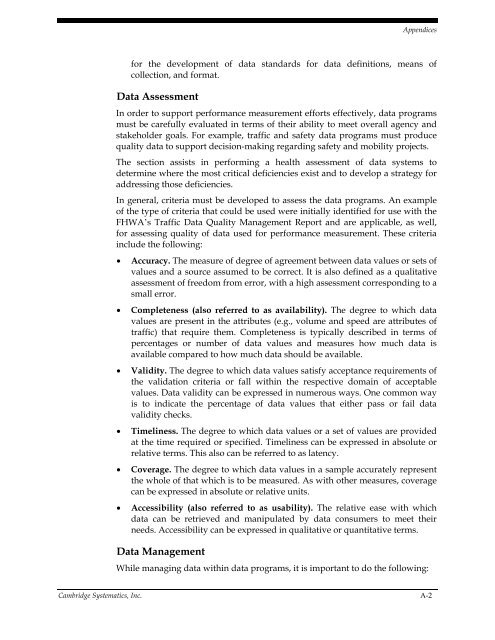CDOT Performance Data Business Plan - Cambridge Systematics
CDOT Performance Data Business Plan - Cambridge Systematics
CDOT Performance Data Business Plan - Cambridge Systematics
You also want an ePaper? Increase the reach of your titles
YUMPU automatically turns print PDFs into web optimized ePapers that Google loves.
Appendices<br />
for the development of data standards for data definitions, means of<br />
collection, and format.<br />
<strong>Data</strong> Assessment<br />
In order to support performance measurement efforts effectively, data programs<br />
must be carefully evaluated in terms of their ability to meet overall agency and<br />
stakeholder goals. For example, traffic and safety data programs must produce<br />
quality data to support decision-making regarding safety and mobility projects.<br />
The section assists in performing a health assessment of data systems to<br />
determine where the most critical deficiencies exist and to develop a strategy for<br />
addressing those deficiencies.<br />
In general, criteria must be developed to assess the data programs. An example<br />
of the type of criteria that could be used were initially identified for use with the<br />
FHWA’s Traffic <strong>Data</strong> Quality Management Report and are applicable, as well,<br />
for assessing quality of data used for performance measurement. These criteria<br />
include the following:<br />
<br />
<br />
<br />
<br />
<br />
<br />
Accuracy. The measure of degree of agreement between data values or sets of<br />
values and a source assumed to be correct. It is also defined as a qualitative<br />
assessment of freedom from error, with a high assessment corresponding to a<br />
small error.<br />
Completeness (also referred to as availability). The degree to which data<br />
values are present in the attributes (e.g., volume and speed are attributes of<br />
traffic) that require them. Completeness is typically described in terms of<br />
percentages or number of data values and measures how much data is<br />
available compared to how much data should be available.<br />
Validity. The degree to which data values satisfy acceptance requirements of<br />
the validation criteria or fall within the respective domain of acceptable<br />
values. <strong>Data</strong> validity can be expressed in numerous ways. One common way<br />
is to indicate the percentage of data values that either pass or fail data<br />
validity checks.<br />
Timeliness. The degree to which data values or a set of values are provided<br />
at the time required or specified. Timeliness can be expressed in absolute or<br />
relative terms. This also can be referred to as latency.<br />
Coverage. The degree to which data values in a sample accurately represent<br />
the whole of that which is to be measured. As with other measures, coverage<br />
can be expressed in absolute or relative units.<br />
Accessibility (also referred to as usability). The relative ease with which<br />
data can be retrieved and manipulated by data consumers to meet their<br />
needs. Accessibility can be expressed in qualitative or quantitative terms.<br />
<strong>Data</strong> Management<br />
While managing data within data programs, it is important to do the following:<br />
<strong>Cambridge</strong> <strong>Systematics</strong>, Inc. A-2

















